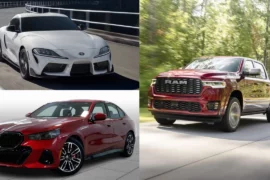Are you looking to buy an SUV in 2025 that not only suits you but your dear family as well but hasn’t gotten anywhere? If so, your misery ends here as you are now in good company.
SUVs have become the go-to ride for American families and for all the good reasons. They are practical, roomy, flexible, and easy to go by whether you are hauling multiple sports gear, child car seats, groceries, or all of the above for that matter.
There are so many makes, models, advanced technology, and features out there that figuring out which SUV would be perfect for your life seems no less than a full-time job.
And that’s where this guide comes in.
I live in a close-knit family in Denver and have seen each of the members struggling in their way to find the right ride. My sister’s shopping for her very first SUV back in 2022 was a different experience from my brother-in-law right now. He is looking for a new ride as both of his kids have outgrown car seats and it feels cramped in their current car. And the list goes on. When you are close as a family, such a big decision of one person or family automatically indulges others in the process.
All the chaos I have witnessed over the years has taught me one important thing about car buying, which is, that what might work for your sister, brother, neighbor, friend, or coworker might not be the right one for you.
The reason you may ask? It is simply because of your personal needs. You may be going after extra space for car seats, more gas mileage, easy maneuverability, and more. Thus, when your requirements and preferences differ from others, you need an approach different from theirs.
I have designed this blog to help you figure out everything with utmost simplicity and clarity, without creating any car-related confusion. We will walk through major decisions that you will have to make, from choosing the right size to understanding safety tech, fuel types, and even what to expect when you finally go for a test drive. No B.S., just real-world information that will smooth out your next move.
So let’s kick this off.
Why SUVs Resonate With So Many American Families Today
Over the past five years, SUVs have taken over American driveways, marking a major shift in the automotive demography. Today, more and more families are finding that traditional sedans and minivans don’t quite check all of their requirement boxes anymore. What a typical native family wants is a vehicle that can help them juggle their everyday chaos with a bit of comfort and a whole lot of confidence. This is exactly what SUVs bring to the table.
Back in my days from college to my early working life, I swore I had never driven a big ride like an SUV as I found them unappealing. However, now with a beautiful wife, two lovely kids, and a dog, I finally realized why my family always made a fuss about getting a spacious ride. The space and flexibility you get are truly life savers.
Today, many modern SUVs also come with smart tech touches like hands-free liftgates, in-car Wi-Fi, or built-in navigation that syncs with your phone, making your life easier with kids and busier lifestyle to juggle. What’s even better is that with better engineering, SUVs are no longer the gas guzzlers. You can easily find fuel-efficient gasoline to hybrids and full electric options with competitive mileage and less maintenance to worry about.
Different Types Of SUVs That You Can Buy

All SUVs share basic traits like elevated seating position, a rear cargo area built into the cabin, and a five-door layout, yet they still differ in terms of shapes, sizes, strength, how they are built, and what they offer the best. This year, sport utility vehicles are more refined, more fuel efficient, and more purpose-driven than before.
Here is a breakdown of the main types that you will find in showrooms, catering to different lifestyles and driving needs.
1. Subcompact
These are the smallest SUVs on the market, generally referred to as a step up from a hatchback. They are ideal for individuals, couples, or small families who want an elevated ride with little extra room. These are affordable, easy to park, and fuel-efficient. The only downside is that these cars are not built for multiple passengers and hefty gear.
- Best for: Singles, couples, or small families in urban areas
- Pros: Easy to park, budget-friendly, great fuel economy (often 30+ mpg combined)
- Cons: Limited cargo and rear-seat space, lower towing ability, not ideal for more than one car seat
- Typical price range: Starting from low $20,000s
- Popular available models: Honda HR-V, Subaru Crosstrek, Hyundai Venue
2. Compact
The compact SUVs are where most buyers begin their search. These rides offer a great balance between size, features, and affordability. They provide more seating and cargo space without killing efficiency.
- Best for: Small families, first-time SUV buyers, suburban driving
- Pros: Versatile size, solid fuel economy (~28–30 mpg combined), plenty of safety features, more comfort and tech than subcompacts
- Cons: Back seat may feel tight for three adults, limited towing power
- Typical price range: High $20,000s to $40,000
- Popular available models: Toyota RAV4, Honda CR-V, Kia Sportage, Ford Escape
3. Mid-Size
This particular type of models are ideal for growing families or anyone who is looking for extra room. What’s even better is that you have options to choose from a two or three-row layout, giving you the flexibility between school drop-offs, weekend road trips, long-distance travels, light towing, and more.
I would personally recommend it for people whose kids are quite small (still in child seats) as the space is enough and you save money by not switching to bigger models.
Why is that? Well, my neighbor Johnsons, a beautiful family with three kids bought a three-row Jeep Grand Cherokee L, a midsize model. Their reason for buying a midsize three-row ride instead of a full-size one with a similar number of seats is that they get impressive cargo space for all their everyday tasks and regular weekend outdoor activities, and the passenger space was good to go as their kids are quite small. Thus, by knowing exactly what their lifestyle demands, they got a ride offering more within their budget.
- Best for: Families of 4–6 members, long-distance drivers
- Pros: Spacious, better towing (up to 5,000 lbs on some models), more and strong engines, 2 or 3-row options
- Cons: Lower fuel economy (averaging 22–25 combined), can feel bulky in tight spots
- Typical price range: Mid $30,000s to $55,000+
- Popular models: Ford Explorer, Honda Pilot, Toyota Highlander, Jeep Grand Cherokee L
4. Full-Size
If you are a big family that needs a giant space for seating, luggage, and other gear, this is your segment. Generally, built on truck platforms, full-size SUVs are the most spacious and powerful in this type and come with serious towing, off-road prowess, and pricier tags.
- Best for: Large families, heavy towing (boats/trailers), long-distance travelers
- Pros: Maximum seating and cargo room, high towing capacity (up to 8,500+ lbs), great highway presence, usually AWD or 4WD
- Cons: Lower fuel efficiency (~18–20 mpg), higher price tags, not easy to park in compact spaces
- Typical price range: $50,000 to over $100,000 for luxury ones
- Popular Available models: Chevrolet Tahoe, Ford Expedition, GMC Yukon, Jeep Wagoneer L
5. Crossovers
While buying SUVs, you will come across the term crossover, which is not a type. This term simply dictates that the model is built on a car frame, not the truck frame, a common occurrence for most modern models. Crossovers offer smoother ride quality, better fuel efficiency, and easy handling while looking and feeling like traditional ones. A crossover variant of all the types mentioned above is right for you unless you wish to do some serious towing or off-roading.
What to Consider When Choosing an SUV

Now that you know the different types of SUVs you can purchase this year, let us talk about how you can choose the one that actually fits like a missing piece from a puzzle in your life. Below, I have laid down some non-negotiable factors that you must at least give a thought to before going ahead and finalizing a deal.
Family Size (Now and Future)
Buying a vehicle is an expensive affair; thus you need to think long-term. Think about how many people, including the kids, you will be having in your ride daily. For a small families, a midsize model with two-row seating is good. We have a thoroughly revised list of vehicles that are best for small families which you can explore before buying.
However, if you plan on having more kids or often carpooling with grandparents or friends of your kids, a larger model with three-row seating seems like a smart move. But to know for sure, you can just bring your entire family for a test-sit like I did when I bought my Kia Telluride a few years back. I even made my little ones climb into the third row to check how easy or tough it was to access it, plus whether it was a chore to fold down the second-row seating. If everyone in your family feels comfortable, your option passes the fit check.
Cargo Space
Beyond seating, people consider the stuff you will be carrying regularly. Is your cargo mostly groceries and backpacks, or do you often have strollers, coolers, and sports equipment back there? Your vehicle needs to complement your everyday life. You can opt for three rows even if you occasionally use the last one as it always provides extra seating and cargo space.
Maneuverability
You can go as big as you want; however, it comes with hardships related to handling. The bigger the vehicle, the harder it is to maneuver or park, especially if you are living in city environments or urban areas like Denver, Seattle, New York, or others. Also, think about your parking situation at home, your workplace, and places you frequent.
City-friendly SUVs are the way to go in such a scenario as automakers take into account every possibility for particular region friendly rides. However, if you still find a ride big enough to hinder your everyday life, you may want to trade off the extra space for easy maneuverability.
Engine and Fuel Options
This year Americans have more choices than ever in how their SUVs are powered. The default gasoline engines are not joined by efficient hybrids and even fully electric ones, providing for all kinds of buyers. The gas models are still popular for their upfront affordability and ease of refueling whereas hybrids are excellent for stop-and-go driving like dropping and picking up kids from the school and errands.
There are Plug-in hybrids (PHEVs) that give you gas for long trips and electric range for shorter commutes. Lastly, there are fully electric engines that are quiet, low maintenance, and increasingly practical as long as you have easy access to reliable charging.
All of these options are great, but they come with varying running costs. On average, a gas engine model might cost you 15 to 20 cents per mile to fuel, whereas it will be only around 5 to 7 cents in the case of an EV.
Pro Tip: If you’re on the fence, test-drive one of each of these engine types. The experiences are surprisingly different and may change your preference on the go. Who knows if the instant torque of an EV might win you over, or you might prefer the traditional feel of a gasoline engine? Hands-on testing will tell you what feels right.
Drivetrain
It is not only the engine but the drivetrain that matters too. If you live in regions with extreme weather conditions like heavy snow, all-wheel drive (AWD) can make a big difference during winters whereas front wheel drive (FWD) is better suited for most suburban driving. Rear-wheel drive (RWD) is the right choice for rigorous towing whereas four-wheel drive (4WD) is what you must go for if you are serious about off-roading.
In addition, also consider how the SUV shifts. Continuously variable transmissions (CVTs) are more common these days as they are smooth and help with maintaining efficiency. But there are people who either prefer the feel of traditional multi-speed automatics or the raw handling of manual transmission.
Your Everyday Life
Your lifestyle plays a big part in your car purchase. If your daily routine consists of tight city parking or weaving through school pick-up lines, go smaller. However, if you are frequently doing road trips, highway commutes, or hauling outdoor gear, focus on getting the bigger size to get better comfort and cargo access. And if you are an outdoor adventure junkie having every weekend reserved for exploration, camping, or boating, an off-roader with strong towing prowess is a must.
Fuel Economy
The efficiency of a vehicle is crucial as it is a clear indicator of how much you will be going to pay for fuel. As a family who will be doing pretty much every errand in their new SUV, you need to know if keeping it will cost you more than you have anticipated. Trust me, with the rising gas prices, you do not want a fuel guzzler.
The U.S. Environmental Protection Agency, EPA determines the mpg and MPGe rating for all the vehicles sold in America based on the car manufacturer’s self-reporting and EPA testing. Ratings are provided for three types of driving: city, highway, and combined (an average of city and highway). Go to the EPA’s official website and find ratings for new as well as older year’s models.
Safety Features and Driver-Assistance Technology
The safety of your loved ones on the road is paramount. Luckily, the current model year comes with better automotive safety tech than ever with many features that were earlier considered luxury now available as standard integration.
Look for advanced driver assistance features like automatic emergency braking, blind spot alerts, rear cross-traffic warnings, and lane-keeping assist that work well in preventing accidents altogether. If you are going to have kids in the rear, look for rear-seat reminders (alert you to check the back seat when you turn the car off to prevent accidentally leaving a child or pet behind), LATCH anchor setup (if you need a child seat in the car), and wide-opening doors for car seat loading and unloading.
Not only this, a surround-view camera system can be a game changer in crowded parking lots. And if you are a proud parent of a teen learning to drive, opting for systems that alert you to hard braking or speeding can offer some peace of mind.
In addition to this, check the crash test ratings of the models from reliable sources like NHTSA (National Highway Traffic Safety Administration) and IIHS (Insurance Institute for Highway Safety). These ratings give you a baseline of how well the vehicle protects its occupants in various crash scenarios. A family SUV should have strong scores in front, side, and rollover tests at a minimum.
Convenience and Entertainment Features
No SUV will do you good if it does not come with appropriate technology on the inside. Having the right tech inside your vehicle makes a huge difference as it keeps everyone connected, entertained, and comfortable. Modern family SUVs are often tech-packed, so look out for an infotainment system with a touchscreen. Opt for larger ones (10+ inches) as they are great for visibility and even your kids will be able to use one. However, make sure it is not too complicated or distracting and can stream music and audiobooks with minimal fuss.
Also, look for connectivity options like wireless Apple Car Play or Android Auto, multi-device Bluetooth, built-in Wi-Fi, and multiple USB ports for charging (in both front and rear rows, mainly if you have kids) features as they can convert your every trip from tiresome to entertaining. A built-in navigation is a must to help you maneuver unknown terrains.
And don’t underestimate the value of things like a power liftgate, one-touch folding seats, or dual-zone or tri-zone climate control. A quiet cabin, comfortable seating, and good visibility all go a long way.
Budget Beyond Buying Cost
Your expenses to own an SUV of your dreams do not end with its sticker price. Thus, you need to take into account the long-term costs of owning it. First, decide whether you want to purchase the vehicle or lease it. Out of the two, buying will be costly, but at the end of the term, you will be owning the vehicle. After this, you need to decide on payment, meaning you will pay the cost upfront financing your purchase. If your choice is the latter, you will have substantial monthly payments to make for the next 5 to 10 years.
Fuel, insurance, maintenance, and depreciation also add to the total cost of ownership, sometimes making an affordable vehicle turn up to be pricey in the long run. Also, two SUVs priced the same can cost very different amounts to own. Thus, when making a budget for car buying, take into consideration the costs beyond MSRP.
Also, if buying a new release out of budget after going through all the processes mentioned above, you can opt for certified pre-owned (CPO) models as they come with lower prices and are often lightly used.
Reliability
If you wish to keep your car purchase for the next five to ten years down the road, you need to consider the reliability and durability of the model you are investing in. Thus, start with learning about your shortlisted brand’s overall reputation for reliability. Car brands like Toyota, Honda, Hyundai, Ford, and Subaru consistently rank high for long-term reliability. It means if you go for a model from one of these automakers you will encounter fewer unexpected repair bills.
To know better check sources like Consumer Reports and J.D. Power Vehicle Dependability Study that conduct large-scale surveys on all the vehicles present on American roads and provide unbiased opinions to help buyers. Additionally, check how much warranty coverage an automaker offers with a particular model. New SUVs typically come with a 3-year/36,000-mile basic warranty and a 5-year/60,000-mile powertrain warranty (that covers engine/transmission). But there are companies like Kia and Hyundai that offer 5-year/60k basic and 10-year/100k powertrain warranty, which can be reassuring if you plan to keep your vehicle for the long term.
In 2025, reliability is no longer just limited to features, rather there is an addition of where a vehicle is built. Today more and more buyers prefer to buy American-made cars, some with the reason to want to support local manufacturing while others believe that domestically built cars would be easier to service. So, if you are any of these people, you will be glad to know that many popular SUVs for U.S. families are actually built in U.S. plants (including some from Japanese brands). Our most reliable American made cars of 2025 article highlights some great examples that also offer the highest level of reliability you can ask for.
Resale Value
It may seem odd to think about selling the car before you have even bought it. However, it is a necessary step as resale value can significantly affect the true cost of owning your new ride. Vehicles with strong resale (often due to reliability and brand reputation) will be worth more when you trade in or sell, effectively returning some of your money.
Brands like Toyota and Honda are famous for retaining value. The domestic brands like Chevrolet and Ford have improved in this area. At present Ford offers some of the most value retaining home models on the market.
Maintenance and Upkeep
One thing as a potential car buyer and future car owner you must understand is that no matter how expensive or how reliable a vehicle you purchase, it is bound to turn problematic if not maintained properly. Every model has its own specific maintenance services and routine which if not followed accordingly can strain your pocket. Thus, think of it as a partnership task. Automaker has provided you with a quality build and now you need to take care of it. Oil changes, tire rotations, brake pads, fluid changes, etc., are the basic tasks that you must perform regularly. You can either perform yourself (if you have the knowledge and the tools) or have a professional do it for you.
Some vehicles may require more. So, before finalizing a model, check how much work you will have to do to keep it in good shape and how much it will cost you on a regular basis. If the length and price of tasks fall under your long-term budget, go for it, if not, better start looking somewhere else.
Brand Choices
The SUV market is booming at such a pace that even automakers like Ferrari who never built anything else than a sports car are also building them. Thus, you can understand how every automaker present in the American automotive market is pulling up its A-game to attract buyers. You have a wide range of choices to choose from, including American brands (Ford, Tesla, Chevrolet, Jeep, etc.), Japanese Brands (Toyota, Honda, Nissan, Subaru, Mazda), Korean Brands (Hyundai, Kia), and Luxury Brands (Lexus, BMW, Mercedes, Audi, Volvo, etc.).
Whatever your brand bias is you can start with that and then move to other options. I’ve always driven Hondas, so I naturally checked out the Pilot and CR-V first. They felt familiar and offered more space, my top priority. However, I was surprised how much I liked the Kia Telluride when I tried it. It was not only more space but the handling, seating comfort, and how well my kids felt in the back that made me buy it despite my bias towards Honda. Thus, I would suggest you test multiple brands as you never know what might click.
New vs. Used SUV, What’s the Better Move for Your Family?

One question that comes up for almost every car-buying family is whether they should go for a brand-new model or opt for a used one to save money. And honestly, there is no one right answer to this question. Your answer to this mind-numbing question depends on your buying timeline, budget, and how comfortable you are with the idea of owning a vehicle that has been owned by someone else before you.
Owning a new vehicle definitely comes with its perks. You get the latest features, tech or otherwise, fresh warranties, and the confidence of being the first person to drive it. A brand-new release makes better sense if you plan to keep your purchase for the upcoming 8 to 10 years. You can build your model at the time of purchase; an option most companies offer to provide buyers with exactly what they want. You can pick the trim level, color, wheels, seating material, and more. Not only this, many brands now offer complimentary maintenance for the first couple of years, which is a nice cost-saver early on.
While it all seems like a fairy tale with the new SUV, you will have to deal with the hefty price tag of a new ride along with the depreciation. New SUVs lose value fast in the first few years, so if money is a sensitive topic, you may want to steer towards used variants.
Used SUVs, especially the Certified Pre-Owned (CPO) ones that are no more than two to three years old and are well maintained can be a great alternative for you. A vehicle that has been well taken care of can still feel new-like and have many of the same features as a new one but cost significantly less. Going for CPO instead of randomly used models adds a layer of trust because they are typically inspected by the manufacturer and include limited warranties that bridge the gap between new and used.
In a Reddit thread discussing preferences for new versus used SUVs, one user shared:
“I prefer used. I can’t stomach the first few years of depreciation. I always buy 3-5 year old vehicles and drive for about 5 years then upgrade. I do love the look and tech in the newer cars but I don’t make a ton of money so I have to save where I can.” — u/flylikeIdo
Thus, you can easily deduce that if your main goal is to minimize your up-front cost while still getting a reliable, family-friendly vehicle, a used SUV with a solid track record might be the smarter financial move. On the other hand, if your priorities have no driving history, zero prior wear, latest features, and long-term ownership, going new might bring you more peace of mind in the long run.
Either way, make sure to weigh your options based on the SUV’s reliability history, warranty coverage, and what your family really needs in the next 5 to 10 years. Don’t get swayed by features that may look intriguing now but hold no value down the road.
What to Expect at the Dealership
When you have gone through different types of SUVs, weighed in all the crucial buying factors, and shortlisted your choices, it is time for a one-on-one examination. Visit the dealerships but do not forget to bring your entire entourage with you. They are a must as they are your permanent passenger.
Load up the kids, the car seats, and anything that you generally have in your car. Do not feel embarrassed about taking those diaper bags, gym bags, outdoor gear, and other items as they will help you decide if the offered space is right for your family or not. Try out all the features one by one. Fold the seats to check if you can do it alone or need another person’s help. See how easy or hard it is for all of you to get in and out, mainly if you are buying a three-row SUV. During my test run for my new vehicle my wife and I took both our kids and their car seats along with their toys, our dog, and the two bags in the trunk. That’s how we chose Telluride instead of the CR-V or Pilot, on which I was adamant.
After everything is in place, ask to test drive with the entire family as they can tell while on the road what feels good or bad to them. Simply, treat your test drives as a mini family road trip and you can learn a lot. If possible, during the test run, drive the vehicle through the routes and places you normally would to test its maneuverability. Try parking it at a store you frequent (do a parallel park if that’s in your routine) to learn if it can fit there. Pay close attention to visibility (especially for blind spots), the quality of the rearview camera quality, how supportive are the seats, how the ride feels, whether it is easy or tough to open the liftgate, how high is the cargo loading height, in-cabin storage, and more.
Try doing the test runs for all your top contenders in a short span like over the same weekend. This way the impressions left by each vehicle are fresh and you can make informed comparisons and choose the one that actually compliments your family.
Once you have the winner, look for seasonal deals to save money. The start and end of the year and a month, start of the week, and major holidays (like Xmas, Thanksgiving, Fourth Of July, and others) are the best times to buy an SUV. Ask for quotes from different dealerships to further sweeten the deal. And if you are thinking of trading in your old ride, it will further bring down your buying cost.
What Else Should You Know Before Buying a Family SUV?
Is it better to buy an SUV at the end of the year?
Yes. The end of the year is one of the best times to buy a new vehicle as during this time dealerships generally offer strong discounts and incentives to achieve their end of the calendar year goals. They are eager to meet the goals and make room in their inventory for new releases. So, if you negotiate with them further, you can get the best deal of your life.
How much should I put down when financing an SUV?
Today, where you can own a vehicle with little or no money down, it is always wise to provide at least 10 to 20 percent as down payment. The larger upfront payment will reduce your loan amount, make you eligible for better interest rates, and even help avoid owing more than the car is worth (which can happen quickly due to depreciation).
Should I consider a demo or loaner SUV from the dealership?
Yes, demo and loaner SUVs can be a smart middle ground between new and used. They are generally priced lower than brand-new versions but still feature low mileage, are well-maintained, and may come with full new-vehicle warranties. If you find one that fits your needs, they’re often excellent value.
Conclusion
Choosing an SUV in 2025 is not about finding a ride that can be labelled as best among available options but rather a model that can satisfy all the demands of all the members of your family, from your partner and kids to your pets. Start with the non-negotiables like space, safety, fuel type, and budget. Take into account your driving demands, what your weekend looks like and will the vehicle still resonate with your needs five years down the road.
Never rush when it comes to making such crucial decisions. Take your time, test drive, compare, listen to what your family has to say. To make a smart buying decision you do not need to be a car expert, you just need the right guide and now you have got one.







